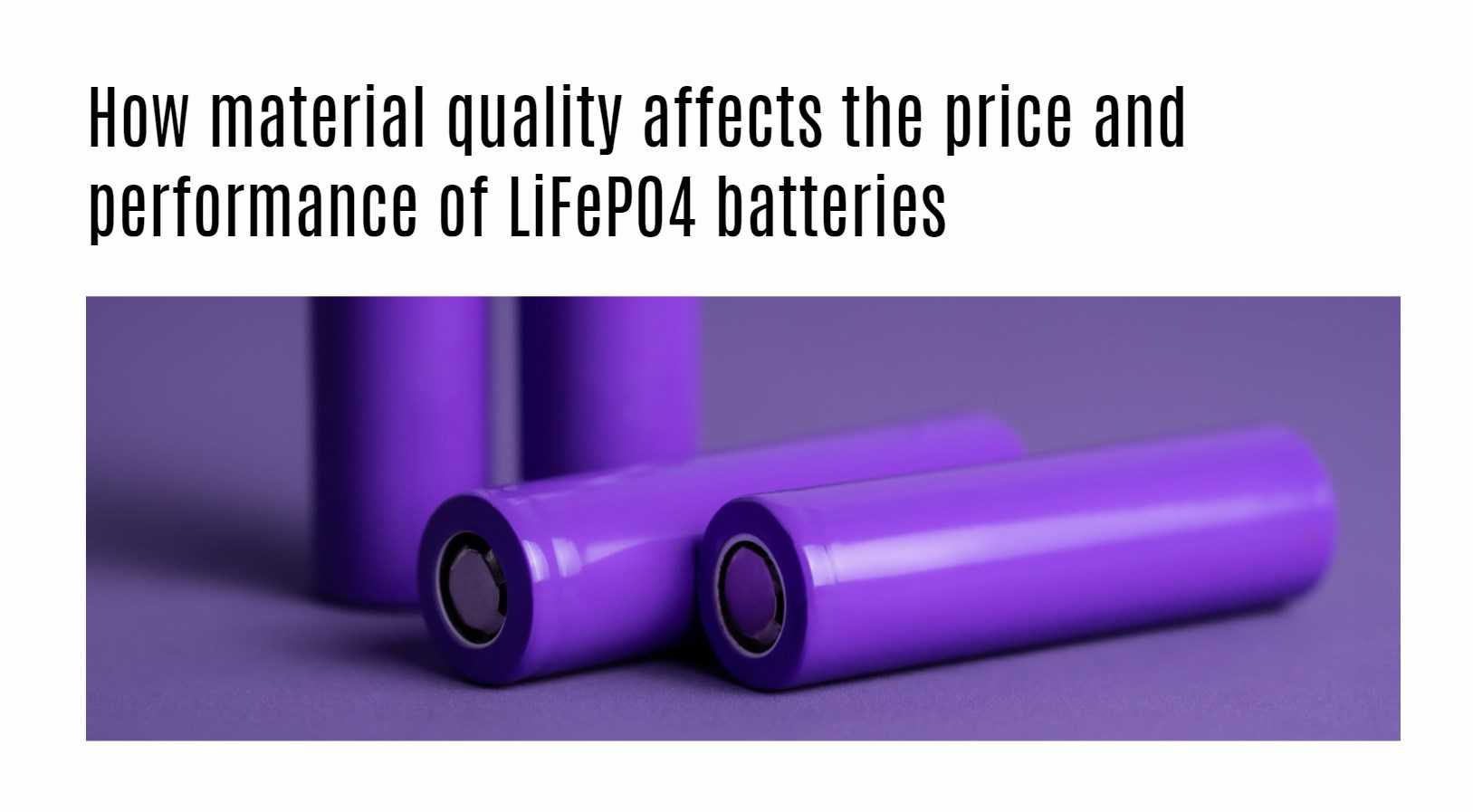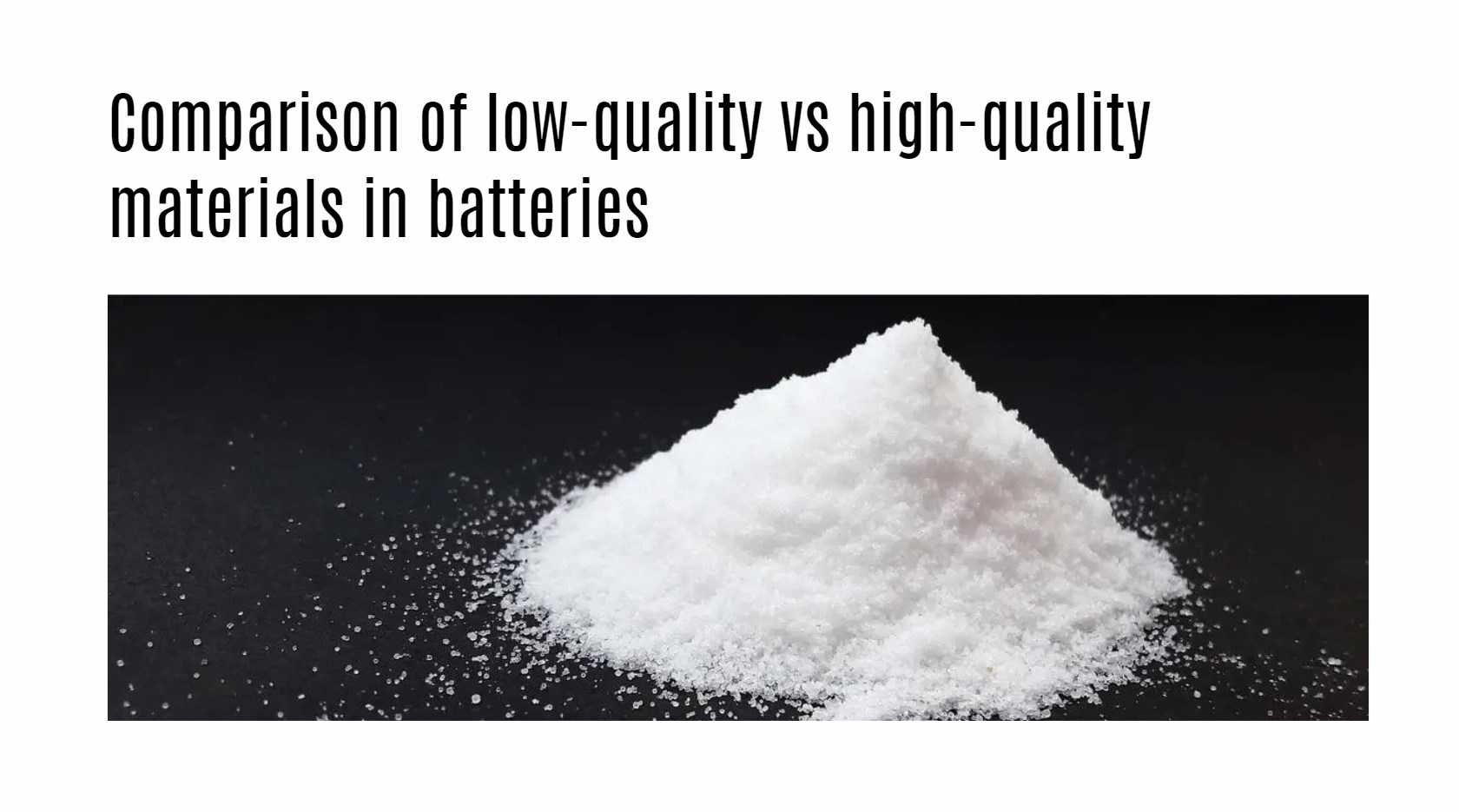-
High-Quality Materials: LiFePO4 batteries utilize high-quality materials, such as lithium iron phosphate for the cathode and graphite for the anode. These materials offer better stability, conductivity, and safety compared to lower-grade alternatives. They enhance energy efficiency, lifespan, and overall performance, ensuring optimal battery performance.
-
Impact on Price and Performance: Investing in LiFePO4 batteries made with high-quality materials may come at a higher initial cost. However, the long-term benefits outweigh the price difference. High-quality materials provide better stability, longer lifespan, and improved energy efficiency, resulting in cost savings over time and enhanced performance.
Factors that determine battery performance and price
-
Material Quality: High-quality materials used in battery manufacturing enhance stability, efficiency, and longevity. Investing in batteries made with top-notch materials ensures better performance and reliability.
-
Design and Construction: The design and construction of battery cells impact their overall performance and durability. Well-designed and properly constructed battery cells contribute to better efficiency and longevity.
-
Technology and Features: The technology used in manufacturing batteries influences their price point. Advanced technologies and additional features can enhance battery performance but may also increase the cost.
Impact of material quality on battery performance
-
High-Quality Materials: Batteries made with high-quality materials exhibit better energy efficiency, longer lifespan, and improved overall performance. These materials contribute to reliable power storage, longer run times, and increased reliability.
-
Impact on Battery Performance: Using high-quality materials enhances energy efficiency, allowing batteries to store and deliver power more effectively. It also extends the lifespan of the battery, reducing the need for frequent replacements. High-quality materials contribute to better performance, ensuring that the battery operates optimally and reliably.
Types of materials used in LiFePO4 batteries
-
LiFePO4 (Lithium Iron Phosphate): LiFePO4 is a recent cathode material used in LiFePO4 batteries. It offers advantages such as low cost, excellent safety, and high cycle durability. LiFePO4 batteries are commonly used in applications that prioritize safety and long cycle life.
-
Other Lithium-Ion Battery Materials:
a. Lithium Cobalt Oxide (LiCoO2): LiCoO2 is known for its high energy density but comes at a higher cost. It is commonly used in portable electronic devices like mobile phones and laptops.
b. Lithium Manganese Oxide (LiMn2O4): LiMn2O4 is a cost-effective cathode material with enhanced safety and thermal stability. It finds applications in power tools, medical devices, and powertrains.
c. Lithium Nickel Manganese Cobalt Oxide (LiNiMnCoO2): LiNiMnCoO2 offers a balance between energy density and power output. It is used in power tools, e-bikes, and other electric powertrains.
d. Lithium Nickel Cobalt Aluminum Oxide (LiNiCoAlO2): LiNiCoAlO2 provides high specific energy and long lifespan. It is commonly found in applications like electric vehicles and power tools.
Comparison of low-quality vs high-quality materials in batteries
When it comes to LiFePO4 batteries, the quality of materials used plays a significant role in determining their performance and price. Low-quality materials may result in inconsistent battery output, shorter lifespan, and potential safety hazards. On the other hand, high-quality materials are carefully selected to ensure stability, efficiency, and longevity.
Low-quality cathode or anode materials can lead to lower energy density and reduced overall capacity. This can translate into shorter operating times for devices powered by these batteries. In contrast, high-quality cathodes and anodes offer better conductivity and enhanced energy storage capabilities.
Wholesale lithium golf cart batteries with 10-year life? Check here.
Moreover, using subpar electrolytes or separators in LiFePO4 batteries can compromise their efficiency and cycle life. High-quality electrolytes help maintain stable voltage levels during charge-discharge cycles while premium separators prevent short circuits and improve overall safety.
In essence, opting for high-quality materials when manufacturing LiFePO4 batteries is crucial for achieving optimal performance, reliability, and value in the long run.
Want OEM lithium forklift batteries at wholesale prices? Check here.
Real-life examples of how material quality affects battery performance and price
Let’s delve into real-life scenarios that illustrate how material quality impacts the performance and price of LiFePO4 batteries.
Imagine two electric vehicle manufacturers using different grades of cathode materials in their battery packs. Manufacturer A opts for high-quality, pure LiFePO4 while Manufacturer B chooses lower-grade alternatives to cut costs.
After a year of usage, it becomes evident that vehicles from Manufacturer A have better range retention and faster charging times due to the superior material quality. On the other hand, vehicles from Manufacturer B start showing signs of degradation sooner, requiring more frequent replacements and maintenance.
The cost difference between these two options may have been noticeable during purchase but proves to be insignificant when considering long-term efficiency and durability. This showcases how investing in high-quality materials upfront can lead to substantial savings over time.
Importance of investing in high-quality LiFePO4 batteries
Investing in high-quality LiFePO4 batteries is crucial for achieving optimal performance and longevity. These batteries are designed to provide reliable power storage for various applications, from electric vehicles to renewable energy systems. By choosing batteries made with superior materials, you can ensure better efficiency and durability.
High-quality LiFePO4 batteries are engineered to deliver consistent performance over an extended period. They have a higher energy density, allowing them to store more power in a compact size. This means longer run times and increased reliability when powering your devices or equipment.
Additionally, premium materials used in these batteries contribute to enhanced safety features, reducing the risk of overheating or short-circuiting. Investing in quality ensures peace of mind knowing that your battery system is built to last and operate safely under demanding conditions.
When considering the long-term benefits of high-quality LiFePO4 batteries, it becomes clear that investing upfront will ultimately save you money and time in the future. Quality batteries offer better cycle life, meaning they can be recharged more times without losing capacity. This translates into cost savings over the lifespan of the battery as replacements are less frequent.
Conclusion
The quality of materials used in LiFePO4 batteries plays a significant role in determining their performance and price. Investing in high-quality batteries not only ensures better efficiency and longevity but also contributes to a safer and more reliable energy storage solution. It is essential for consumers to consider the material quality when purchasing LiFePO4 batteries to maximize their benefits and overall satisfaction.








